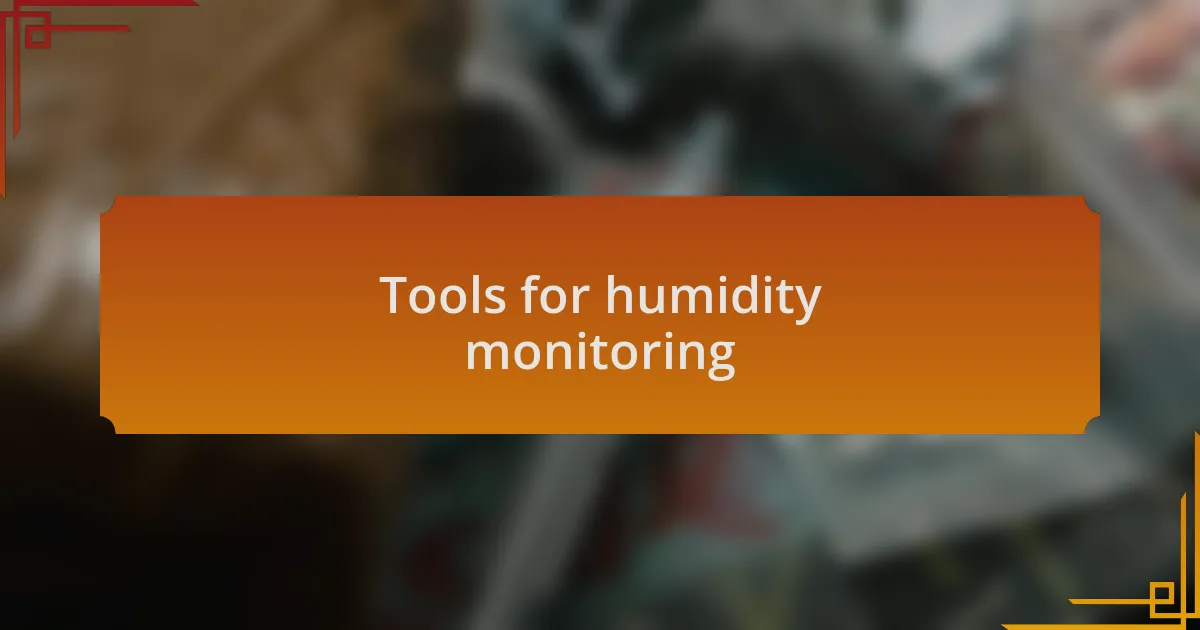Key takeaways:
- Humidity is critical for cannabis cultivation, affecting plant health, growth, potency, and flavor, with varying needs at different growth stages.
- Proper humidity control prevents mold and bud rot, significantly impacting yield and overall plant resilience against pests and environmental stress.
- Using tools like hygrometers and humidity control systems can lead to improved plant health, while trial and error enhances understanding of optimal conditions.
- Long-term humidity management benefits include healthier plants, better yields, and enhanced flavor profiles in the cannabis harvest.

Understanding humidity in cannabis
Humidity plays a crucial role in cannabis cultivation because it directly influences plant health and growth. When I first started growing, I was amazed by how variations in humidity could affect the leaves’ appearance and even the aroma of my plants. Have you ever noticed how a higher humidity can bring out more vibrant colors in cannabis leaves?
Maintaining the right level of humidity is essential during different stages of growth. For example, seedlings thrive in a high humidity environment, around 70-80%, while flowering plants prefer lower humidity levels to prevent mold and other issues. I remember experiencing a mold outbreak when I didn’t adjust the humidity properly during flowering. That was a tough lesson learned!
It’s also important to understand that the ideal humidity levels can vary based on your growing techniques, whether it’s soil-based or hydroponics. I’ve experimented with different setups and found that investing in a hygrometer to monitor humidity can drastically improve my results. How do you keep track of humidity in your growing space?

Importance of humidity control
Humidity control is vital for maximizing the health and yield of cannabis plants. I learned this the hard way during one of my early grows when I neglected to monitor humidity levels. I watched helplessly as my once-thriving plants succumbed to bud rot, a heart-wrenching sight that reinforced the importance of maintaining appropriate humidity.
Understanding the preferred humidity levels for each growth stage is not just about preventing mold; it directly affects the potency and flavor of the final product. I remember being amazed when I adjusted the humidity for my flowering plants, allowing their aroma to intensify. It’s incredible how a little adjustment can transform the experience of your harvest, don’t you think?
In my experience, proper humidity can enhance the plant’s resilience against pests and diseases. A few seasons back, I found that my plants were more robust during dry spells when I kept the humidity in check. This not only saved my crop but also instilled a sense of confidence in my growing technique. Have you ever noticed how a healthy plant can better withstand environmental stress?

Common humidity issues in cultivation
One of the most common humidity issues I’ve faced in cultivation is high humidity during the flowering stage. This is a critical period when the risk of mold and bud rot skyrockets. I remember one season, I was blissfully unaware until I discovered my precious buds developing a fuzzy layer of mold. It was disheartening, and it made me realize just how essential it is to monitor humidity, especially as plants swell with moisture.
Conversely, low humidity presents its own challenges, particularly during the seedling and vegetative stages. I learned this lesson when my seedlings appeared droopy and unhealthy, struggling to absorb moisture through their leaves. It was a stark reminder that cannabis plants thrive within a specific humidity range; anything outside of that can negatively affect growth. I still recall the feeling of relief when I finally corrected the humidity levels, watching my young plants perk up almost immediately.
Lastly, fluctuating humidity levels can lead to inconsistent growth patterns in cannabis plants. In one of my grows, I noted how wildly varying humidity impacted the size of my buds; some were impressive, while others seemed stunted and lacking vigor. This disparity not only affected my yield but also left a lingering frustration in my mind—why didn’t I notice the signs earlier? Realizing the connection between consistent humidity and uniform growth has made a meaningful difference in my cultivation journey. Have you ever found yourself in a similar situation with your plants?

Strategies for managing humidity
When it comes to managing humidity, I’ve found that using dehumidifiers can be a game-changer, especially during the flowering stage. I remember setting mine up in the grow room, watching with satisfaction as the humidity levels dropped steadily to the optimal range. It felt empowering to take control of the environment, knowing I was reducing the risk of mold and protecting my hard work.
In contrast, when dealing with low humidity, I’ve had great success with humidity trays filled with water or even wet towels placed around the grow area. On one occasion, I placed trays beneath a fan to extend moisture evenly throughout my space, and the difference was like night and day. My young plants perked up, and I could almost see a collective sigh of relief as they absorbed the added moisture.
Another strategy that’s worked for me is monitoring the weather closely and adjusting my environment accordingly. During particularly humid days, I find myself checking my grow room multiple times to ensure the fans and ventilation systems are working optimally. Have you ever noticed how changing just a few factors can lead to significant improvements? It’s these small adjustments that often pave the way to creating a thriving cannabis garden.

Personal experiences with humidity control
When I first started growing cannabis, I didn’t fully appreciate how critical humidity control was. One time, I overlooked it during a particularly wet season, and my plants suffered from white powdery mildew. The panic I felt when I spotted those telltale signs was intense; it taught me the hard way that maintaining optimal humidity isn’t just about comfort for the plants—it’s crucial for preserving their health.
I also remember experimenting with different humidifiers after a few rough grows. I was frustrated when my plants seemed sluggish, not realizing that too much moisture was hanging in the air. The moment I switched to a hygrometer to monitor levels actively was enlightening; I could finally pinpoint what worked best for my setup. It was gratifying to see my girls thriving just because I took that extra step—I frequently ask myself, why didn’t I do this sooner?
What stands out most in my experience is my journey of learning through trial and error. I recall one grow session where I placed a moisture meter directly into the soil, and it revealed a stark difference in humidity levels. It opened my eyes to the importance of not just surface humidity but what’s happening at the root level. Have you ever experienced that “aha” moment when everything clicks? It’s remarkable how understanding the nuances of humidity transformed my approach to cultivating healthy plants.

Tools for humidity monitoring
When it comes to monitoring humidity, I find that a simple digital hygrometer can be a game-changer. In my early days, I used to rely on guesswork and my gut feeling, but after investing in a reliable hygrometer, I realized how much I had been missing. It’s fascinating to see the readings change throughout the day; have you ever looked at your hygrometer and felt a wave of relief or dread depending on what you see?
Another tool that I swear by is a combination of a dehumidifier and humidifier with smart capabilities. I used to run into issues where the humidity would drop too low at night, so I set up a humidifier that automatically adjusts based on the hygrometer’s readings. The first time I walked into my grow space and noticed even, stable humidity levels, I couldn’t help but smile—it was as if I had finally found the missing piece of the puzzle.
I also recommend using an app to track humidity over time. I remember when I first started documenting my readings; it was an eye-opening experience to see the correlation between humidity fluctuations and plant health. Have you ever thought about how convenient it would be to have that data in the palm of your hand? By analyzing trends, I was able to adjust my approach, leading to healthier plants and better yields.

Long-term benefits of humidity management
Effective humidity management offers lasting advantages that can transform your growing experience. One thing I’ve noticed over the years is the significant impact stable humidity levels have on plant resilience. When I managed to maintain consistent humidity, I saw my plants adapt better to stressors, leading to a more robust harvest. Have you ever noticed how strong plants seem to thrive in the right environment?
In my own grow room, I used to battle with mold and other pests due to fluctuations in humidity. Once I learned to control these levels carefully, I not only reduced pest issues but also improved my overall yields. It’s incredible how much of a difference it makes when you’re not constantly fighting off those unwanted guests. Doesn’t it feel great to know that with proper management, you can have healthier plants and less to worry about?
The long-term benefits extend beyond just the immediate harvest. I’ve come to appreciate how good humidity management can enhance the overall flavor profile of my cannabis. When I ensured that my plants were in an ideal environment, the rich aromas and potent flavors truly stood out. Isn’t it rewarding when your hard work translates into a product that’s as enjoyable to consume as it is to cultivate?